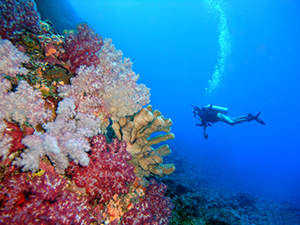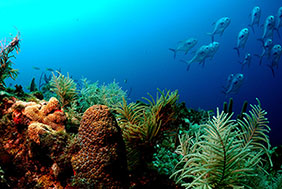-
Home
-
Data & Publications
-
Regional Portals
- About Regional Portals
- Florida
- Navassa Island
- Puerto Rico
- Flower Garden Banks
- U.S. Virgin Islands
- American Samoa
- Commonwealth of the Northern Mariana Islands
- Federated States of Micronesia
- Guam
- Main Hawaiian Islands
- Republic of the Marshall Islands
- Northwestern Hawaiian Islands
- Republic of Palau
- Pacific Remote Island Areas
-
CRCP Activities
- Glossary
National Coral Reef Monitoring Program:
Tracking Biological Trends

Fishing pressures, climate change, and pollution are just some of the many stressors on marine life within coral reef ecosystems. Researchers identified the following biological indicators to assess the condition of coral reefs and associated reef fish communities.
- Coral reefs – coral diversity, distribution, abundance, colony size, and condition
- Reef fish – reef-related fish diversity, distribution, abundance, and size
- Habitats – composition, complexity, and key species
Data are collected through diving surveys of shallow-water (0-30 meters) areas. Scientists and coastal managers then use these data to evaluate coral reef and fish population management strategies, document endangered or invasive marine species, and assist with local monitoring efforts.
Outreach Products
- NCRMP 2022 Biological Sampling infographic
- NCRMP 2020-2021 Biological Sampling infographic
- NCRMP 2019 Biological Sampling infographic
- NCRMP Biological Monitoring one-pager
Atlantic Biological Sampling Protocols
- 2022 Benthic Community Assessment Survey Field Protocols for U.S. Atlantic
- 2022 Coral Demographics Survey Field Protocols for U.S. Atlantic
- 2022 Reef Visual Census (RVC) Fish Survey Protocols U.S. Atlantic
Technical and Peer Reviewed Publications
- Pacific Reef Assessment and Monitoring Program - Benthic REA Monitoring Summary Reports
- Pacific Reef Assessment and Monitoring Program Data Report
- Viehman, T Shay, Groves, Sarah H, Grove, Laura Jay W, Smith, Steven G, Mudge, Laura, Donovan, Caroline, Edwards, Kimberly, Towle, Erica K. 2023. A quantitative assessment of the status of benthic communities on US Atlantic coral reefs using a novel standardized approach, Bulletin of Marine Science, 99(0):000–000. 2023, doi: https://doi.org/10.5343/bms.2022.0025
- Viehman, T. S., Grove, J. G., Blondeau, J., Cain, E., Edwards, K. F., Groves, S. H., Krampitz, N., Langwiser, C. Siceloff, L. Swanson, D., Towle, E. K., and Williams, B. (2023). National Coral Reef Monitoring Program, Biological Monitoring Summary – Florida: 2022. NOAA Technical Memorandum NOS CRCP 48. https://doi.org/10.25923/e6xg-1989
- Viehman, T. S., Edwards, K. F., Blondeau, J. W., Cain, E., Grove, L. J. W., Groves, S. H., Krampitz, N., Langwiser, C., Siceloff, L., Swanson, D., Towle, E. K., and Williams, B. (2023). National Coral Reef Monitoring Program, Biological Monitoring Summary – Flower Garden Banks: 2022. NOAA Technical Memorandum NOS CRCP 47. https://doi.org/10.25923/1re3-s258
- Grove, L. J. W., Blondeau, J., Cain, E., Edwards, K. F., Groves, S. H., Hile, S. D., Langwiser, C., Siceloff, L., Swanson, D. W., Towle, E. K., Viehman, T. S., and Williams, B. National Coral Reef Monitoring Program, Biological Monitoring Summary – U.S. Virgin Islands and Puerto Rico: 2021. NOAA Technical Memorandum NOS CRCP 46 pp. https://doi.org/10.25923/zj1v-z618
- Grove, L.J.W., J. Blondeau, E. Cain, I.M. Davis, K.F. Edwards, S.H. Groves, S.D. Hile, C. Langwiser, L. Siceloff, D.W. Swanson, E.K. Towle, S.T. Viehman, B. Williams. 2022. National Coral Reef Monitoring Program, Biological monitoring summary - Florida: 2020–2021. NOAA Technical Memorandum NOS CRCP 44. 52 pp. doi: 10.25923/9jns-v916
- Edwards, K.F., J. Blondeau, L.J.W. Grove, S.H. Groves, S.D. Hile, M.W. Johnson, C. Langwiser, L. Siceloff, E.K. Towle, T.S. Viehman, and B. Williams. 2021. National Coral Reef Monitoring Program, Biological monitoring summary – U.S. Virgin Islands and Puerto Rico: 2019. NOAA Technical Memorandum NOS CRCP 40. 27 pp. doi: 10.25923/fdp6-qv15
- K. McCoy, J. Asher, P. Ayotte, A. Gray, T. Kindinger, and I. Williams. 2019. Reef fishes and benthic habitats of the main Hawaiian Islands. PIFSC data report DR-19-039. https://repository.library.noaa.gov/view/noaa/22057.
- K. McCoy, J. Asher, P. Ayotte, A. Gray, K. Lino, T. Kindinger, and I. Williams. 2018. Reef fishes and benthic habitats of the Pacific Remote Islands Marine National Monument and American Samoa. PIFSC data report DR-19-008. https://repository.library.noaa.gov/view/noaa/19591.
- Heenan A, Williams ID, Acoba T, DesRochers A, Kosaki RK, Kanemura T, Nadon MO, Brainard RE. 2017. Long-term monitoring of coral reef fish assemblages in the Western central pacific. Scientific Data. 4:170176. https://doi.org/10.1038/sdata.2017.176.
Complete list of publications produced by the NCRMP Biological Monitoring Team.
Data Collections
Supporting Documentation (Please note this encompasses only a subset of documentation for the submitted data. Contact the data providers with further questions.)


